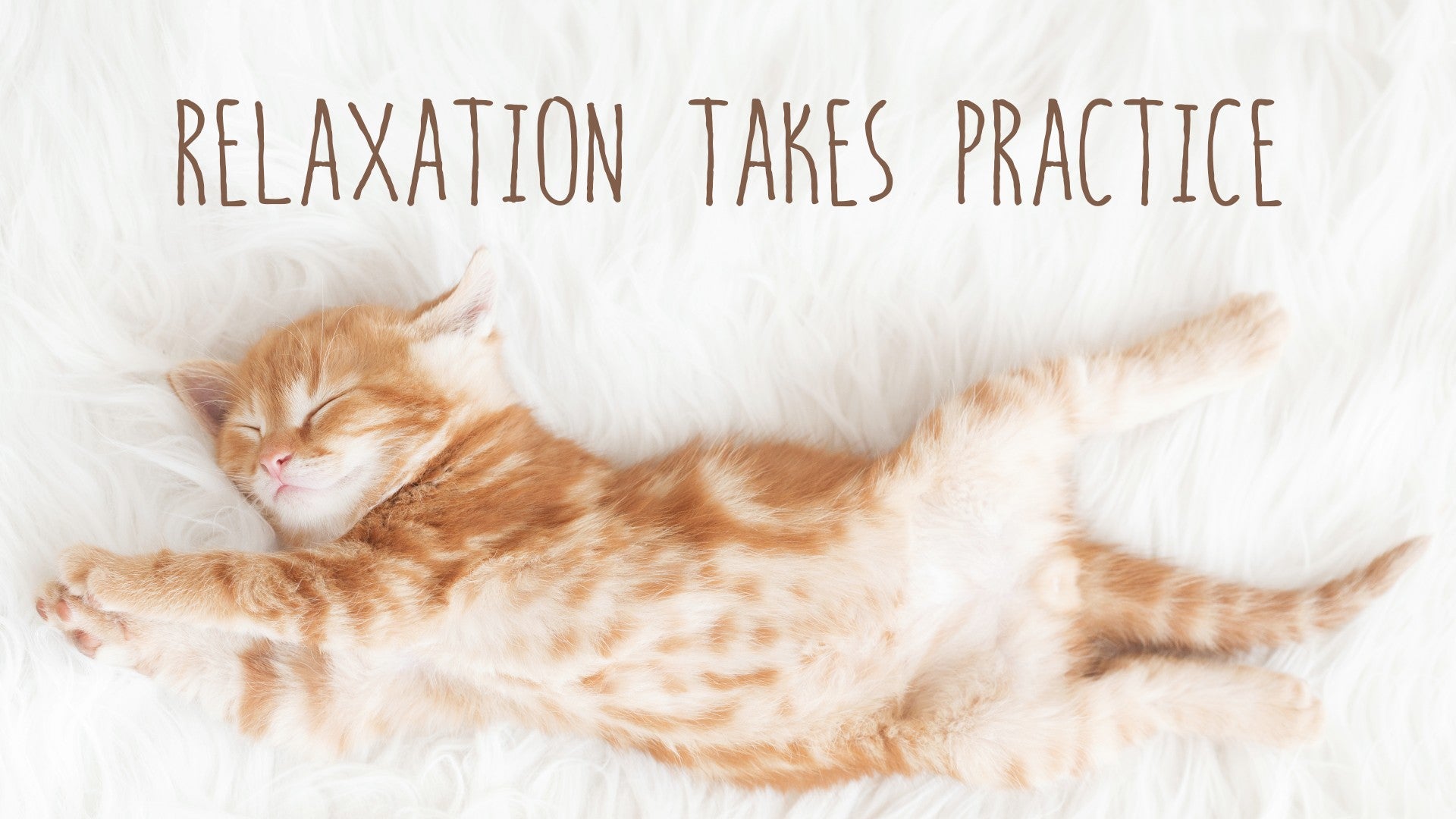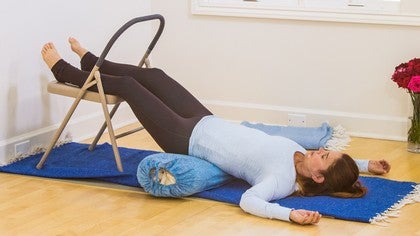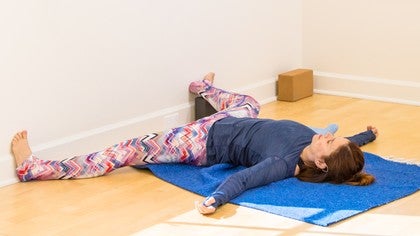Description
About This Video
Transcript
Read Full Transcript
(waves crashing) Namaste everyone. Thank you for joining me on this restorative yoga practice today, it's called Comfortable and Calm. All the yoga poses are specifically sequenced to keep you comfortable and calm, and also guiding you toward the final relaxation pose, Shavasana, which we'll spend about ten minutes in. Let's get started. You only need a few yoga props.
The first is a chair. This is a special yoga chair because the back has been pushed out of it, but you can also use a chair from your house or your office. You just need to be able to slide your legs to the back end of it. The next thing that you'll need is a blanket. As you can see I've covered my mat with a blanket.
And you'll also need one bolster. So we get started with the first pose, which is called Sukhasana, it's easy pose. You'll take the blanket and fold it up into the fourths, and then into this foundation position. Fold it one more time, so it's made a little pad, a little seat for you. You'll want the clean, folded edge facing toward the chair.
I'm gonna go ahead and sit down on that front edge of it, stretch my legs out, and bring the chair pretty close to me. I'm gonna start with my right foot underneath my left thigh, follow with my left foot underneath my right thigh. So I'm in a cross-legged position. Place the hands underneath the buttock flesh, and slide the buttock back till you feel that you're right on the buttock bones. Place the hands on top of the chair seat, lift the spine on an inhalation, and as you exhale, lengthen yourself toward the seat, fold the arms, and let the forehead rest on a forearm.
We'll be here for about two minutes. Relax the shoulders. Part of practicing the calm and comfort in the restorative yoga practice is about paying attention to the breath. So if you find yourself bumping up against a couple of sensations, invite yourself to take a slow inhale and deliberately relax to the exhalation. At any time, if you need to come out of the pose before you hear the instruction, please feel free to do so.
There's no need to grip the chair with your hands, keep the hands loose and relaxed. See if it's possible for you to shift your weight forward toward the front of the pelvis, rather than sitting on the backside. If you feel your hips beginning to open a little more, you may decide to slide the chair away from you just a little bit, in order to accommodate for that opening. Notice the breath you're taking right now, and follow it with one more concentrated breath. And then use the inhalation to lift the head and the chest, bring your hands to the seat again, push away with straight arms, and stretch the legs out in front of you.
Pause here. And we'll prepare for the opposite side. Starting with the left leg this time, bringing it in toward the thigh, and following with the right. Adjusting the pelvis, adjusting the buttock flesh as necessary, bring the chair closer toward you, hands on the seat of the chair, lift the spine on an inhale, and as you exhale, hinging to come forward, resting your forehead on a forearm. Shoulders soften.
And we'll be here two minutes. When you change the legs, the hip stretch is different, because one leg is on top, and one leg is underneath. So just begin to feel the discrepancies, if any, or the differences, and see if you can relax away to the pelvis a little bit more. The leg that's on the bottom is the leg that you'll feel more of the stretch in. But it should be a minimal stretch.
Temper all your restorative stretches by just keeping a little bit of sensation in the shape. And value the shape and the breath more than the depth of the stretch. If you do find that you can take a little bit more, then go ahead and lift the head, and slide the chair out in front of you, maybe just a little bit, elongate again, and return to the position with your head on a forearm. Be mindful of how the back feels, so that there's not much load and rounding in the lower back. Can you weight the hips as you let the exhalation go?
Finish the breath that you're on, and take one more. And then inhale, lift the head and the chest, push up against the seat of the chair, and come up to a seated position. Hands anywhere you like, close the eyes, straighten the legs, and pause. And gently open the eyes. Let's prepare for the next pose.
We're headed toward a twist which is on the front side of the body. We don't need the chair or the blanket for this, just the bolsters, so I'm gonna push those two props out of the side, and bring the bolster back over to the mat. I'm gonna take the bolster and bring it so that it's parallel to my mat. I'm gonna take my right hip and bring it so it's right in the middle of the bolster. My legs are bent, and I can stack my top knee on the bottom ankle.
Bring the hands on either side of the bolster, and weight your hips one more time. Inhale, lengthen your spine, now as you exhale, slide your arms forward, turning your torso with the left side of the chest, moving faster to the bolster than the right side. If you want more sensation in your neck, or you can deal with the sensation that's there, it's minimal, then turn your head to the right. If you do not want that and it feels uncomfortable, or the neck shortens, turn your head toward the legs, to the left. And then settle your weight of the body.
We'll be here for two minutes. Feel free to make any adjustments that seem appropriate. Snugging yourself close to the bolster. Fanning your elbows out a little, giving your chest a little more room. Notice where your interest is.
Bring it to the breath. If your head is turned away from the knees, tuck your chin, roll your head slowly to the left to rest on the right cheek. Notice the breath you're on, listen to it, and take one more. Then slide your palms down underneath the shoulders, push with the arms till the arms straighten, pause at the top, in any comfortable seated position, eyes closed and quiet. Gently open your eyes.
Moving to the opposite side is easy, just swivel yourself around to the left hip. Bringing that hip right in the middle, the legs bent, with the top knee resting on the bottom inner ankle. Bringing the hands on either side of the bolster, taking an inhale to lengthen that spine, and exhale to turn to your left as your right chest tries to come faster, you're guiding it lower to the bolster, faster than the left side. Bringing your elbows and forearms to the floor. Either keeping your head turned away from the knees, or turning your head toward the knees.
Whichever feels comfortable. Settling the weight of the body, all the way into the support. Letting those elbows spill out to the sides, that chest can open. We'll be here for two minutes. Notice where your interest is, and bring it to the breath.
Because we're dealing with both sides of the spine, you may feel one side considerably tighter or looser than the other. There's easy ways to adjust this as your spine begins to open up, and the rotation gets a little deeper. For this you can slide your left palm down, sort of underneath your shoulder, press to the palm, lift, and take a little bit more rotation in the mid-back, and lower again so that more of that right side of the torso rests on that support. Adjust your arms again to the beginning position. Once again, notice where the awareness is, the interest.
Bring it to your breath. I have to mention that drooling does happen in this pose. Listen to the breath you're on now, then follow it with one more breath. If your head is turned away from the legs, tuck your chin, slowly roll your head in the direction of the legs, slide your palms down underneath the shoulders, slowly push up, return to a comfortable seated position, and pause. Twists are a great way, it's like you're just wringing out any stress that's in the spine.
Let's open the eyes, and move toward a very neutral position that's great to do after any rotation, and that's Child's Pose. We already have the bolster, so there's nothing else we need. Go ahead and separate the legs, and slide the bolster all the way inside the legs, so separate them enough so that when you close your legs, you can kinda snug right up against the bolster. Weight your pelvis and hips down into your heel bones, as you're starting to slide your torso forward. You feel the belly hit, you feel the ribs and the chest, bring your elbows and forearms on either side of the support, turn your head, the first time, to the right.
Your right nostril up, your left cheek down. Let the breath come in and out like the waves of the ocean. Ride each inhale, and ride each exhale. We'll be here for another minute. Notice where your awareness is, bring it to the breath.
Listen to the breath that you're on, deliberately relax on the exhale. And then gently tuck the chin, turn your head in the opposite direction, settle the weight of your head and your chest, the rest of your torso, and your pelvis. And we'll be here for one minute. Go ahead and listen to the breath that you're taking right now, relax your body into that exhale. Tuck your chin, roll it toward the center, so you're on your forehead now, slide your palms down underneath the shoulders, keep your head down so the chin is parallel to the chest, with an inhale, push through straight arms, lean your weight back, and you can just walk yourself back until you're sitting on your heels.
Slide the bolster forward, come into any comfortable seated position, close the eyes, and pause. And gently open the eyes. So we're headed toward the last two poses, and both of them are used with the chair. First one is legs at the chair, then it's Shavasana on the chair. So I'm just gonna move the bolster to the side a little bit, bring the chair back over.
And just because this is a yoga chair, I'm gonna turn it around cause you can see that the very edge of the chair comes up just a little bit, I'm gonna turn it around, so that my feet are more elevated than the backs of my knees. If you want, you could use a blanket underneath your head, but I'm gonna start by just sliding myself close to the chair, catching the backs of my knees on the seat of the chair, and I want the legs softly bent, so you don't wanna be like this, the knee should be forward of the pelvis. Then lifting the hips up, sliding the bolster underneath me, just at the lower back pelvis, adjusting until I feel it feels right, good and comfortable. And then releasing my arms, with the palms turning up, I like to bring my elbows to a bent position, so they're in this cactus position, but you could bring your arms alongside the body, or out to a T position, you could even rest your hands at your chest or your belly. I'm just gonna spread my shoulder blades, little bit so that I'm flat on that mid-upper back.
Slide my head from side to side, and we'll be here for three minutes. A soft inversion. Noticing where my breath is. Keeping my interest on it. You may find in this slower practice, that even though you're comfortable, the challenge may be to stay calm.
Just let yourself be with whatever arises. You can follow any distraction back to the breath. You can allow whatever wants to come to surface, come to surface. And return to an awareness of the breath to settle, center, steady, and calm. Bring your interest to your breath.
Take a slow inhale, and a deep exhale. Then straighten the arms if they're bent, and go ahead and lift the lower back and slide the bolster out from underneath you, so the lower back can come flat on the floor, depending on how it feels with your lower back and legs, you may wanna come closer, or further away from your chair. And then release the arms out again. Turn the palms up. Settle your spine.
And now we'll rest here for seven minutes. Nothing to do. Nowhere to go. And all is well. Nothing to do.
Nowhere to go. And all is calm. Gently bring your awareness back to your breath. Lengthen your inhale a little, deepen your exhale. Let some movement start to stir through your fingers, your toes, your wrists and your ankles.
Slowly pull your legs off the seat of the chair, draw them in towards your chest. If it feels good to rock on your lower back, go ahead and rock side to side. Then release the weight of your body over to the left side, in the fetal position. Lean your chest into the floor, use your palm to push and come up, head is the last thing that lifts. Bring yourself in a comfortable seated position.
Eyes closed. Join your palms at your chest. Thank you for sharing your practice with me today. And may you be comfortable in your body, and calm in your mind. Namaste.
Relaxation Takes Practice
Comments
You need to be a subscriber to post a comment.
Please Log In or Create an Account to start your free trial.













